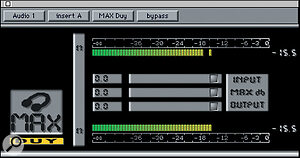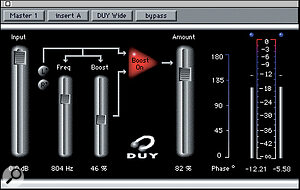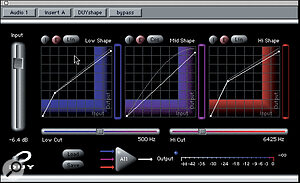Paul White tries out a new range of European software plug‑ins with stylish interfaces and innovative features.
Plug‑ins are becoming an increasingly significant part of working with digital audio, and it's nice to see a new company making an appearance in this important area. DUY (don't ask me how you pronounce that!) are a Spanish company producing plug‑ins for Digidesign's TDM and Audiosuite plug‑in architectures, Adobe Premier and Steinberg's Cubase VST. Though some of their plug‑ins cover ground already trodden by the likes of Waves, Spatializer, QSound and Steinberg, they do offer a different approach, with some genuinely innovative twists and wrinkles.
The Basics
The five plug‑ins reviewed here are TDM versions and comprise DaD Valve, DaD Tape, Max DUY, Wide DUY and Shape DUY. All conform to Digidesign's overall plug‑in layout guidelines, but the visual presentation is a little more adventurous than say, Waves, who tend to value clarity of interface above showmanship. Within Pro Tools 4, any of the plug‑ins reviewed here may be automated, while Pro Tools III allows only static processing.
All these TDM plug‑ins come on a single Mac‑format floppy disk with the usual limited‑install protection system. There are two installs per disk, with a de‑authorisation procedure for removing a plug‑in when you need to change hard drives or upgrade your computer. I hate these things with a vengeance, but until a better copy‑protection system comes along, I guess we're stuck with them. Installation on my Mac was straightforward, and once the plug‑ins were placed inside the DAE plug‑ins folder, I only had to reboot and I was ready to try them out.
<h3>DaD VALVE
Valve emulation in software is nothing new, but DUY have modelled a whole range of triode, pentode and tetrode valves at different bias and drive levels, to create a very flexible plug‑in. Their system deals with the dynamic and spectral aspects of valves separately, because although it's well known that valves compress signal peaks when they're overdriven, the resulting harmonic structure varies with the valve type and biasing arrangement.
The Spectrum part of the process simulates the frequency and transient response of the valve, while the Dynamic part emulates the distortion caused by the valve's non‑linearities. In addition to the input level slider, there's also a drive control called the Pusher, arranged as a horizontal fader, but there's no output level control, so it's not always possible to balance the processed and direct levels for comparison. A further control, called Lobe Flip, inverts the effect of the valve, to reverse the positive and negative‑going characteristics, which may be quite different in a typical valve circuit. With symmetrical input material this will make no difference, but where the material being processed is very asymmetrical (brass waveforms are very asymmetrical, for example), the subjective difference can be quite noticeable.
The various valve characteristics are arranged as a matrix of 40 presets for the Spectrum processing and 40 for the Dynamic processing, each set being laid out as a drop‑down 5 x 8 menu of instrument icons, to provide some idea as to which types work best with which sounds (the same icons are present in both sections). A Link button forces the same preset to be chosen from both Spectrum and Dynamic settings, but unlinking it allows any preset from one group to be combined with any preset from the other. This may all sound a bit anorakish until you listen to the effect, but it's an easily verifiable fact that some kinds of non‑linearity sound great on some instruments or voices and awful on others.
In either case, mono or stereo signals may be treated, though for some reason I could get no sound out of this plug‑in, or the DaD Tape plug‑in, with my Pro Tools III system unless it was used in stereo. As this type of plug‑in goes, the effect is both authentic and controllable, and used with care it can add a little welcome character back to an all‑digital recording.
DaD Tape
As you can work out from its name, this is quite obviously a tape saturation emulator, but rather than simply approximating tape compression, it is actually based on physical models of five industry‑standard machines, to include noise, non‑linearities, frequency response ripples and so forth. There's also an idealised noiseless tape mode, just in case the thought of analogue hiss throws you into a panic. What's more, you can dial in the side‑effects of two popular noise reduction systems, and the virtual tape speed can be set to 7.5ips, 15ips or 30ips.
The user can select the required tape characteristics via buttons, but otherwise has control only over input and output level (stereo metering is provided). Just as with tape, the effect is only obvious at high signal levels, but sonically DaD Tape seems very authentic — although, just like real tape, the effects are more subtle than you might expect. Having the different simulations helps match the treatment to the sound being processed, but I feel the control system could be better. For example, I'd like to see a separate control for setting up the tape drive to allow saturation at lower input levels, and proper tape‑style metering to show how much the virtual tape is being pushed into the virtual red [DUY say that DaD Tape uses plasma meters instead of VU meters because they are more exact than a good VU meter emulation]. Though this plug‑in does exactly what it says on the tin — and then some — I think if I already had the DaD Valve plug‑in, I could get close enough to a tape sound not to need both.
Duy Max
You guessed it — a level‑maximisation processor using what DUY describe as Intelligent Level Optimisation. Unlike analogue limiters, this plug‑in updates its parameters on a sample‑by‑sample basis, to restrict the dynamic range of signal peaks in a very unobtrusive way. In addition to the input gain slider, there's a Max slider to set the threshold above which processing takes place. The manual states that if the input signal comes close to 0dB, the Max slider range is limited to around 6dB, and above this point unwanted artifacts may appear. An output slider sets the maximum peak value of the processed signal and meters show the levels of the input and output signals simultaneously. DUY Max may be used in mono or stereo.
DUY Max is a very easy plug‑in to use, and providing you don't push the processing too far, the effect of limiting is largely invisible. However, as a long‑time user of Waves' L1 limiter, I feel that Waves provide a better set of controls and more meaningful metering.
Duy Wide
Not a virtual cockney used‑car salesman, but a stereo width enhancing plug‑in, DUY Wide is designed to work with stereo inputs only, and its aim is to make the sound‑stage appear wider than the speaker spacing. In addition to a stereo enhancement amount slider, there's an input gain slider and a variable frequency boost equaliser to help compensate for any spectral change that might result from the processing. QSound use a similar EQ system with their plug‑in, as spectral change often occurs when processing is used to widen the stereo image, and just in case the source material turns up with one channel out of phase, there are also separate phase‑invert buttons for each channel.
The EQ boost can be switched in and out, but on my Pro Tools III system I couldn't get the boost controls to work at all. Switching in Boost increased the overall level, but neither the Frequency or Boost control had any effect. I'm prepared to believe this was due to some foible of my own system, but if you're looking at this plug‑in, it would still be advisable to check everything works properly on your system.
Phase meters show how much processing is taking place, and they also provide an indication of how the process might affect mono compatibility. Up to 40% should be fine, but above that you need to check more carefully. (Perhaps a mono check button on the plug‑in would have been a good idea?) Stereo level meters continuously monitor the processed output.
How effective the process is depends on the material being treated, and in my experience that applies to all the competing products too. On most mixes, the apparent spaciousness of the sound is increased at the cost of a little 'up‑frontness'. Any tonal change should be small enough to compensate for by using the Boost control. The effect isn't always as dramatic as you might wish, and I've found much the same with the competing systems — a lot depends on the characteristics of the source material. It's usually best to process just elements of the mix rather than the whole thing — then you can use more intense processing on reverb, delay and sound effects, for example.
Duy Shape
It might sound like a slimming biscuit, but DUY Shape is actually the most original and most interesting of all the DUY plug‑ins. It's not an EQ, it's not a compressor and it's not an enhancer, yet it combines elements of all three and more. Again operable in mono or stereo, DUY Shape splits the audio spectrum into three bands, which the user can vary via two adjustable crossover frequency sliders. Representing each band is a graph showing input against output, rather like a compressor, and these are the Shapers. The default condition is a diagonal line on each graph, depicting that the input and output are linearly related.
Grabbing the top point of the line and pulling it down reduces the level in that frequency band, but that's all, hence the ability to equalise. Any shape other than a straight line (you can add as many points as you like by clicking), will cause the input/output relationship to be non‑linear, but rather than simply affecting gain, as is the case with a compressor, this process affects the shape of the waveform being processed. In other words, it introduces a degree of level‑related distortion under precisely controlled conditions. The type of waveshaping depends on the shape of the input/output line, and this may be bent into any shape you like by adding points and then dragging them. It's also possible to define different curves according to cosine or six logarithmic rules, and these all produce subjectively different results.
The outputs from all three bands are summed in a mixer; repeated clicking on the mixer icon lets you solo any band or hear the the full mix. A few preset curves are provided so you can load them in and hear what the plug‑in can do straight away, but coming to grips with making your own patches takes a little while, as it's not always obvious what actions will produce what results. A little dabbling confirms that this plug‑in is incredibly flexible, but I didn't find it particularly intuitive. For example, the leaflet hints that you can create frequency‑dependent compression effects, but from what I can make out, the only compression that occurs is as a result of waves being squashed at the top by means of the shaping process. Similarly, you can expand the waveforms to make the peaks higher still, but this isn't the same thing as conventional expansion. There's no explanation given of what to expect from the different curve types, so you really have to 'suck it and see'. Even so, the results can be intriguing. You could shape only the top band to emulate a traditional enhancer, shape just the bottom band to get a nice analogue saturation effect, or shape everything, and alter the relative levels of the three bands, to totally change the sound of a mix or instrument.
Of the five plug‑ins, this is definitely the most intriguing, and I feel that a little perseverance would be well rewarded. There's potential for enhancing individual sounds as well as full mixes, and some of the non‑linear effects sound very 'analogue', especially when applied to the bass end of the spectrum.
Summary
These are very sophisticated plug‑ins from a company with a strong reputation in innovative software design, and, aside from a couple of odd foibles that are most likely to be associated with my specific audio system, they worked exceptionally well. If anything, I feel the designers have tried to make the user interface too graphically interesting, and the time might have been better spent on making the products more intuitive to use, but it really doesn't take long to get familiar with them. I feel Waves have done a far better job on the interface front, but there's no denying that DUY have added some features and processes that are quite unlike anything anybody else is doing. The Shape and Valve processors are my two favourites, but all do what they claim, and with very high audio resolution. I have no doubt that we'll be hearing a lot more from DUY as the plug‑in market continues to expand.
The Neuronium Connection
Keen readers of SOS, and fans of electronic musician Michel Huygen, also known as Neuronium (interviewed in SOS way back in June 1993), may have spotted that DUY the software company share their name with Huygen's studio DUY. We wondered if they were related, and made enquiries. It turns out that they are — though we're told that the software department has no connection with Michel Huygen. Anyone interested in some company background should check out the DUY web site, at www.duy.es
Pricing
TDM versions:
DaD Valve £586.32
DaD Tape £374.82
DUY Max £292.57
DUY Wide £292.57
DUY Shape £527.57
Audiosuite versions:
DaD Valve £323.12
DaD Tape £233.82
DUY Max £186.82
DUY Wide £186.82
DUY Shape £276.12
Adobe Premier versions:
DaD Valve £135.12
DaD Tape £99.87
DUY Max £88.12
DUY Wide £88.12
DUY Shape £104.57
Cubase VST versions:
DaD Valve £323.12
DaD Tape £233.82
DUY Max £186.82
DUY Wide £186.82
DUY Shape £276.12
Sound Designer II versions:
DaD Valve £351.32
DaD Tape £252.62
DUY Max £222.00
DUY Wide £229.12
DUY Shape £327.82
Bundles are also available: for example, a bundle containing all five plug‑ins for the TDM platform costs £1279.57. All prices include VAT. DUY Max, DUY Shape, DUY Wide and DaD Valve are also now available for the MOTU audio system. Contact Syco for prices.
Pros
- Ingenious added‑value features.
- Good audio performance.
- DUY Shape is particularly flexible.
Cons
- User interface not always as intuitive or clearly set out as it could be.
Summary
Though some of these plug‑in have obvious counterparts from other manufacturers, the feature sets are sufficiently different to make them well worth trying out, and they all offer high audio resolution and work very well.





